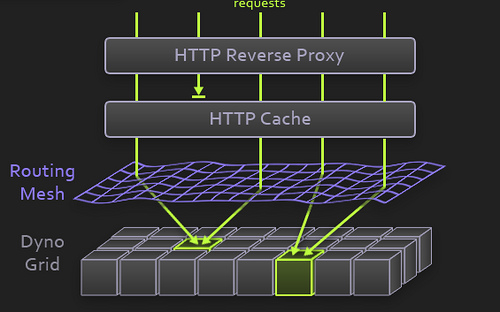CSC/ECE 517 Spring 2015/ch1a 3 RF: Difference between revisions
No edit summary |
No edit summary |
||
| Line 68: | Line 68: | ||
== OpenShift == | == OpenShift == | ||
===What is it=== | ===What is it=== | ||
| Line 78: | Line 77: | ||
Openshift supports multiple languages and frameworks like Ruby on Rails Python, Java, Node.js | Openshift supports multiple languages and frameworks like Ruby on Rails Python, Java, Node.js | ||
The developer workflow for Openshift works as follows | The developer workflow for Openshift works as follows | ||
# You create your application using IDE or command-line. It can be a Ruby on Rails, Django Node.js or Java servlet. As soon an application is created OpenShift will spin a gear for that application. | |||
# Then you select the services from OpenShift which are needed for the application. These are called ‘Cartridges ‘ in OpenShift. For example if you are creating Ruby on Rails application, you would select Ruby, Postgres/Mysql, Redis, MongoDB, SendGrid. | |||
# The deployment of the code is a simple ‘git push’. You can connect your CI server for automated testing. | |||
# Incase of scaling adding multiple gears is as simple as clicking few buttons and it adds gears load balanced with HAProxy. | |||
Revision as of 21:44, 5 February 2015
Heroku vs OpenShift vs Digital Ocean
Heroku OpenShift and Digital Ocean are some of many options out there for hosting and/or managing your web applications. Below we will give detailed descriptions of how each of them work, and finish with a comparison along with recommendations based on what type of applications you're trying to run, or what type of background you have.
Heroku
What is it
Heroku is a company that provides what is commonly referred to as Platform as a Service (PaaS). PaaS essentially means that they provide and maintain everything that one would ordinarily have to do to host a website. It turns hosting and managing a web-service into a very simple process that only requires a few lines of configuration code and a git push to get going.
How does it work

Heroku let’s you deploy applications written in a multitude of languages, from Ruby, to Node.js, Python, PHP and others. Initially you have to tell Heroku which parts of your application are runnable, this is specified in a Procfile. For established frameworks like Ruby on Rails, Heroku can figure out what it needs to execute (‘rails server’) You can then deploy the application to heroku using git. This requires a single push command. Heroku automatically retrieves any dependencies required to build the application and assembles all the code along with any generated assets and the dependencies into a bundle called a slug. These slugs contain everything that the heroku nodes need to run the application. Heroku runs applications using Dynos. Dynos are virtual Unix containers that provide the environment required to run an application. These are preloaded with the slugs and run the command established in the Procfile (in the case of rails, ‘rails server’). In order to achieve the most throughput possible from the Dynos all requests initially go through Heroku’s routing mesh. This routing system decides which Dyno to allocate to the request, and makes sure to intelligently spread the workload across all Dynos at all times
What does it provide
Hosting
Heroku is hosted on Amazon Web Services (AWS) servers. They have heroku in two locations. US East, and EU West.
Load Balancing
The router spreads all HTTP requests efficiently across web dynos. Effectively balancing the server load.
Database
Heroku uses a Postgres SQL database. The database is accessible from all languages supported by heroku.
Logging
Logging is an important part of running a web application. Heroku has a robust logging service that logs all events from the app, the heroku system(error pages, restarting processes, waking up a dyno), and the heroku API ( deploying new code, changing to maintenance mode). You can log from anywhere in your application using standard out or standard error. ( a puts command in ruby would be written to the log) Fetching the logs is as easy as running a command ( heroku logs ) which returns the last 100 log lines by default. Each line includes a timestamp, the source of the log ( app or heroku), the dyno that wrote the log, and the message itself.
Scaling
When running an application on Heroku you pay for a certain amount of dynos. This means that at any given time, you should have a maximum of that number of dynos handling requests to your application. If your application traffic requires you to scale up, a simple command (heroku ps:scale web+5) adds web dynos to your application, effectively scaling up your ability to handle requests.
Why would you use it?
Makes all the setup and maintenance easier. Instead of having to configure and manage the servers yourself, which might require installing and configuring a few dozen apps to guarantee speed, security, logging etc...as well as configuring and deploying a database. Heroku does all that for you, allowing your focus to be on developing the website, not maintaining its infrastructure. It also allows for very easy scaling up or down as needed. This means that as required by the website traffic, you can easily scale up to handle more requests, or scale down if requests are slowing down at a particular time. An example of this would be scaling up right before a major product release, or in the case of e-commerce, right around christmas or black friday, in order to ensure the adequate servicing of the increased number of requests. This scaling up can then be reversed once the product release or the shopping holiday is over.
Limitations
Ephemeral file system
The dynos have an ephemeral file system. This means that as a developer, you never know when files written to disk will disappear. If a dyno stops or is restarted, the files are gone. This means that any applications hosted in heroku shouldn’t rely on any sort of local storage in order to work, since at the drop of a hat, that storage might be gone, and there’s nothing that you can do about it.
Limited locations
Heroku runs on AWS on US East and EU West, this means that if you want to host an application that is targeted at a market that is primarily located far away from either of these locations, ex: Japan, the latency they will experience will be very large. Another problem of the limited locations is that there is no regional redundancy. If you’re running an application on US East, and there’s a US East outage, there’s no backup servers that will allow your application to keep running, and so your application will experience that outage.
Heroku’s free plan uses shared databases. This means that your application will be sharing a postgreSQL database with other applications which means that you cannot have live access to the database. This might make any manual changes to database data, or debugging that requires manually digging into the database, impossible.
OpenShift
What is it
OpenShift is service defined as Platform as a Service provided by RedHat. Platform as a Service is layer of abstraction above Virtual Machine like Amazon EC2. Compared to a vanilla server box, it provides with all the packages and services required to host your production application. It also provides auxiliary services like monitoring, backup, scale up. The software running OpenShift is open sourced called OpenShift Origin.
How does it work
Openshift supports multiple languages and frameworks like Ruby on Rails Python, Java, Node.js The developer workflow for Openshift works as follows
- You create your application using IDE or command-line. It can be a Ruby on Rails, Django Node.js or Java servlet. As soon an application is created OpenShift will spin a gear for that application.
- Then you select the services from OpenShift which are needed for the application. These are called ‘Cartridges ‘ in OpenShift. For example if you are creating Ruby on Rails application, you would select Ruby, Postgres/Mysql, Redis, MongoDB, SendGrid.
- The deployment of the code is a simple ‘git push’. You can connect your CI server for automated testing.
- Incase of scaling adding multiple gears is as simple as clicking few buttons and it adds gears load balanced with HAProxy.
